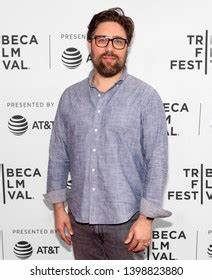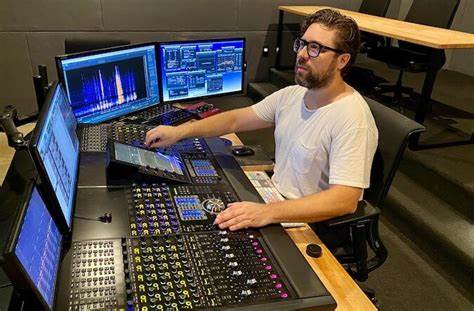By: Victoria Stevens
New York City, NY (The Hollywood Times) 07/19/2023 – Joyland, The Angry Black Girl and Her Monster, First Time Female Director, Hard Times, and Sound of Freedom; what do all these films have in common? The Sound Designer of course!
Nathan Ruyle is the owner and founder of an independent sound design and post-production studio, This is Sound Design. He has facilities in New York and LA where he works on different aspects of the sound design for features, TV shows, podcasts, commercials, and trailers.

“Sound is known as the invisible art. When you do it correctly the audience will never even think about it happening because it creates a world and creates an experience in that world for the audience. Essentially my company takes all the sound elements that you experience in a movie and creates them. For the most part most sound, other than the voices that are recorded on set, is created after the fact. The style of movie that the audience likes to see these days is the composed and crafted naturalism which you can’t really capture on set. It all must be recreated later. I consider myself a sound designer and I consider the work my company does sound design,” shared Ruyle.
When it comes to sound design there are different aspects to consider. Ruyle compares it to production design in a way. “The main question to ask is What does the movie look like? There are different parts of crafting the film around that question, from choosing the paint to picking out the curtains on set. It all relates and creates that visual experience of that specific movie. That is what we do for sound, and it manifests into all other parts of the process like pulling sound effects from sound libraries, creating foley and creating footsteps, and then ultimately mixing it all together in the mix stage so it all works together along with the music,” said Ruyle.
When choosing what genre to work on, Ruyle looks at different variables when it comes to sound design. “There are so many variables that grab me in a script,” explained Ruyle. “I have a track record, as I have done this now for about 20 years. There are certain movies that I have done that are sort of touchstones and people will come to me because they know what I can do for that style of movie. They know that I can take a smaller budget and help it succeed like I did for Joyland. It won the Independent Spirit Awards which was shortlisted for an Academy Award, and that was a smaller budget movie. However, those filmmakers knew that I could take what they had done and help make it a huge impact.
Almost everything I have done has been connected to another project from a producer or director I have worked with in the past.” As a previous professor from California Institute of the Arts (CalArts), Ruyle has helped many students get prepared for the sound industry and the changes that have occurred over the years in this new technology era. “In terms of students entering the industry, we are clearly in a transitional phrase where 5-8 years ago people understood the market and understood what worked and what didn’t. Now, it’s obvious, as we keep seeing two-hundred-dollar movies keep failing, that the audience preference and what is accepted has changed and the market is uncertain. Coming out of Covid, people are hungry for interesting stories that aren’t comic books and aren’t IP based nostalgic storylines. The movies and the movie experience I believe is going to have a big resurgent because the audience is hungry for it,” expressed Ruyle.
“I do believe it can be really daunting for the young people who are entering into the industry, because there is no set way to get into the industry now. You used to be able to intern at a certain studio and work your way up, however things have changed and no longer work like that. That model for doing sound for movies is very industrial and very specialized. That approach where you only specialize in one part of the industry is not that comparable anymore with the tools we have now, with the way the filmmakers what to work, and with the new generation coming into the field they don’t want to work the way the older generation used to work,” said Ruyle.

For most indie projects, sound design can be extremely costly due to the lack of understanding of how sound design works and how much money to spend on investing in a good sound designer. “Sound is one of the trickiest parts of movie making for a few reasons. One is that in the production environment before you get to postproduction there is such an emphasis on the visual capture. If you look at the team of people that it takes to visually capture something you will see a whole army of gaffers, lighting, and all these things to be able to do that. Often times, the sound side is just a couple of people and sometimes in a low budget movie it’s just one person with a boom and a recorder. So, it’s easy to underestimate how important what’s being captured is. I believe that’s because the software is getting better, and people have this notion that they can just fix the sound in postproduction. The truth is what we can do in post now with an experienced engineer who really knows how to harness the tools, you can do a lot.
However, sadly it’s not a linear thing. A lot of low budget films fall under a thrush hold that takes a lot of money to repair the sound from on set and suddenly you start seeing your budget go into a lot of repair time and ADR time,” explained Ruyle.
The moral of the story is to invest in a good sound engineer from the beginning so that your film production doesn’t end up in post-production dilemmas.
As a seasoned sound designer, Ruyle has worked with many accomplished directors and producers. When asked who he would like to work with next, Ruyle had a very unique answer. “What I would love more than anything is to continue to be able to work with the directors that I did their first movie with. The nature of the industry is that moving from that first small feature into a much bigger budget, so often for producers and those that were just starting out with working with a director, we often don’t get to continue and build our career with the director or writer. It’s way different now than what it used to be. Back then the great filmmakers like Tarantino, Christopher Nolan, E.T. Anderson, and the Cohen Brothers, what you will see is that they worked with the same people movie after movie. Who they were as a filmmaker was extended through the people that they worked with, knowing the same language and all. That is what I would love to do and build with directors I have worked with,” said Ruyle.
Credit: Nathan Ruyle
Website: This is Sound Design (tisd.tv)





